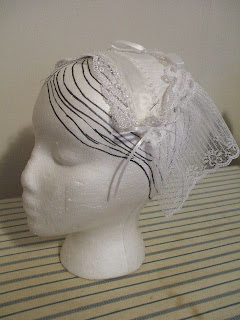Started Dec 25, 2010 Finished Sept 17, 2011
While cutting out my fabric for my 1845 teal plaid gown last year, I decided to also cut out my black silk taffeta for my mourning interpretation gown. My assembly line method was back in business.
I’ve been collecting photos for trim ideas for a mourning gown, and originally I really liked the velvet diamonds trimming this 1850 gown. It looked like a lot of fun handwork.
But sometimes my ideas for my gowns evolve as I see more photos and find trims. What determined how I would eventually trim this gown was a purchase of antique etched black glass buttons.
I thought they would look good following the same front design as the 1845 gown of Queen Victoria. And then I found a photo of another 1840s blue and silver floral gown with the sleeves I liked, and now that has influenced me to want to make a pelerine to go with it. Unfortunately that will cover the pretty trims I plan to put on the front, so it may not stay on me long. But I’m betting I can make that kind of fancy too.
 I also found this wonderful 1840s daguerreotype of a young lady with the ruched trim down the front of her bodice too.
I also found this wonderful 1840s daguerreotype of a young lady with the ruched trim down the front of her bodice too.
I wanted to use the buttons as a focus of my trims on the front of the gown, simply decorative, and I made a pleated self fabric trim to go around the entire front of the bodice and the sleeve cuffs. It would border the row of buttons I would sew down the front of the bodice.
Since I liked the current pattern I was using for a V-neck bodice, Simplicity 3855, I cut the black one out at the same time and sewed the bodice together. I also used the same sleeve pattern I’d made for my turquoise plaid but lengthened it a bit, and sewed the pleated trim just at the edge of the cuffs.
I flatlined my bodice with a navy blue cotton I had and made a bias facing to sew all around it.


That was as far as I got and then worked on it in fits and starts for the next year. I didn’t take any more photos during that time so this is how it started to look with its trim and two of the buttons. I had ten buttons and decided to use them all down the front. I considered doing something to the skirt and I really wanted to sew three rows of velvet bands around the bottom of the skirt as I’d seen in a fashion print. But because this was a mourning gown, I decided to pull the reins in on my trimming frenzy and kept it plain.
For my accessories I made my chemisette and undersleeves from a grey cotton. I used TV 104 for the chemisette and Period Impressions 401 for the undersleeves. I sewed a black soutache trim along the border of the collar and cuffs.


I pinned my watch to my bodice with an antique pin I bought recently, and a jet mourning brooch I bought on ebay from a seller in Norway. The really cool thing is it came from Trondheim, Norway, where my grandmother came from. The back of the brooch has a little window that you can open and put a lock of hair in it. I have some black lace mitts to wear, along with this bracelet I got for a steal at one of our antique shows.
 For my bonnet- I haven’t decided if I’m going to do one like this dated 1847 one in the photo (definitely want to do the flowers on the inside, or the one shown in this fashion print of the mourning gown. The black one seems to be more of a cottage bonnet shape.
For my bonnet- I haven’t decided if I’m going to do one like this dated 1847 one in the photo (definitely want to do the flowers on the inside, or the one shown in this fashion print of the mourning gown. The black one seems to be more of a cottage bonnet shape.


I don’t have the bonnet frame right now and since I’ll be gone for a good part of next month, with only a week after before this needs to be done, I’m seriously considering making this cap out of a grey fabric with black ribbon. The colors will all depend on what kind of fabric or ribbon I can find in the meantime. I don’t want it entirely black since I’m doing second year mourning of black and grey.
I will be wearing this to the Dia de los Muertos candlelight procession on Nov 1 in Old Town San Diego. I’ve been planning & working on it since last year, and at least it’s at the point that it’s wearable now. I have a three tiered ruffled petticoat made from cotton organdy to wear under it, and am currently working on a corded petticoat to go under that. I’m hoping I don’t have to fall back on my past shortcut of wearing a tulle petticoat, or even the great theatre trick of a quilted fabric petticoat. But it is in progress now. The bonnet/cap will have a higher priority though.









































